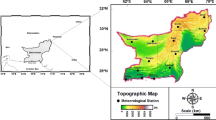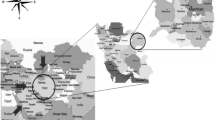Abstract
Precipitation, in short periods of time, is a phenomenon associated with high levels of uncertainty and variability. Given its nature, traditional forecasting techniques are expensive and computationally demanding. This paper presents a soft computing technique to forecast the occurrence of rainfall in short ranges of time by artificial neural networks (ANNs) in accumulated periods from 3 to 7 days for each climatic season, mitigating the necessity of predicting its amount. With this premise it is intended to reduce the variance, rise the bias of data and lower the responsibility of the model acting as a filter for quantitative models by removing subsequent occurrences of zeros values of rainfall which leads to bias the and reduces its performance. The model were developed with time series from ten agriculturally relevant regions in Brazil, these places are the ones with the longest available weather time series and and more deficient in accurate climate predictions, it was available 60 years of daily mean air temperature and accumulated precipitation which were used to estimate the potential evapotranspiration and water balance; these were the variables used as inputs for the ANNs models. The mean accuracy of the model for all the accumulated periods were 78% on summer, 71% on winter 62% on spring and 56% on autumn, it was identified that the effect of continentality, the effect of altitude and the volume of normal precipitation, have an direct impact on the accuracy of the ANNs. The models have peak performance in well defined seasons, but looses its accuracy in transitional seasons and places under influence of macro-climatic and mesoclimatic effects, which indicates that this technique can be used to indicate the eminence of rainfall with some limitations.









Similar content being viewed by others
References
Allen RG, Pereira LS, Raes D, Smith M et al (1998) Crop evapotranspiration-guidelines for computing crop water requirements-fao irrigation and drainage paper 56, vol 300. FAO, Rome, p D05109
Alvares CA, Stape JL, Sentelhas PC, de Moraes Gonçalves JL (2013) Modeling monthly mean air temperature for Brazil. Theor Appl Climatol 113:407–427
Box GE, Jenkins GM, Reinsel GC, Ljung GM (2015) Time series analysis: forecasting and control. John Wiley & Sons
Brath A (1997) On the role of numerical weather prediction models in real-time flood forecasting. In Proceedings of the international workshop on river basin modeling: management and flood mitigation, pp 249–259
Calzadilla A, Rehdanz K, Betts R, Falloon P, Wiltshire A, Tol RS (2013) Climate change impacts on global agriculture. Clim Change 120:357–374
Cooper P (1969) The absorption of radiation in solar stills. Solar Energy 12:333–346
Dao VN, Vemuri V (2002) A performance comparison of different back propagation neural networks methods in computer network intrusion detection. Diff Equ Dyn Syst 10:201–214
De Camargo AP, De Camargo MBP (2000) Uma revisão analítica da evapotranspiração potencial. Bragantia 59:125–137
De Camargo A (1971) Balanço hídrico no estado de são paulo. Boletim Técnico (116)
Feng G, Cobb S, Abdo Z, Fisher DK, Ouyang Y, Adeli A, Jenkins JN (2016) Trend analysis and forecast of precipitation, reference evapotranspiration, and rainfall deficit in the blackland prairie of eastern Mississippi. J Appl Meteorol Climatol 55:1425–1439
Ferraudo AS (2014) Artificial neural networks. In: Sakomura NK, Gous R, Kyriazakis I, Hauschild L (eds) Nutritional modelling for pigs and poultry, chap 7. CABI, pp 88–95
French MN, Krajewski WF, Cuykendall RR (1992) Rainfall forecasting in space and time using a neural network. J Hydrol 137:1–31
Friedman J, Hastie T, Tibshirani R (2001) The elements of statistical learning, vol 1. Springer Series in Statistics, New York
Ghil M, Cohn S, Tavantzis J, Bube K, Isaacson E (1981) Applications of estimation theory to numerical weather prediction. In: Dynamic meteorology: data assimilation methods. Springer, New York, pp 139–224
Gonfiantini R, Roche M-A, Olivry J-C, Fontes J-C, Zuppi GM (2001) The altitude effect on the isotopic composition of tropical rains. Chem Geol 181:147–167
Hall T, Brooks HE, Doswell CA III (1999) Precipitation forecasting using a neural network. Weather Forecasting 14:338–345
Hargreaves GH, Samani ZA (1985) Reference crop evapotranspiration from temperature. Appl Eng Agri 1:96–99
Haykin S, Network N (2004) A comprehensive foundation. In: Neural Networks, vol 2, p 41
Hecht-Nielsen R (1992) Theory of the backpropagation neural network. In: Neural networks for perception. Elsevier, pp 65–93
Karlik B, Olgac AV (2011) Performance analysis of various activation functions in generalized mlp architectures of neural networks. Int J Artif Intell Exp Syst 1:111–122
Kim J-W, Pachepsky YA (2010) Reconstructing missing daily precipitation data using regression trees and artificial neural networks for swat streamflow simulation. J Hydrol 394:305–314
Kuligowski RJ, Barros AP (1998) Experiments in short-term precipitation forecasting using artificial neural networks. Mon Weather Rev 126:470–482
Kuligowski RJ, Barros AP (1998) Localized precipitation forecasts from a numerical weather prediction model using artificial neural networks. Weather Forecasting 13:1194–1204
Kumarasiri A, Sonnadara D (2006) Rainfall forecasting: an artificial neural network approach. Proc Tech Sess 22:1–13
Luk K, Ball J, Sharma A (2000) A study of optimal model lag and spatial inputs to artificial neural network for rainfall forecasting. J Hydrol 227:56–65
Medvigy D, Beaulieu C (2012) Trends in daily solar radiation and precipitation coefficients of variation since 1984. J Clim 25:1330–1339
Mishra SK, Sharma N (2018) Rainfall forecasting using backpropagation neural network. In: Innovations in computational intelligence. Springer, Singapore, pp 277–288
Montana DJ, Davis L (1989) Training feedforward neural networks using genetic algorithms. IJCAI 89:762–767
Nasseri M, Asghari K, Abedini M (2008) Optimized scenario for rainfall forecasting using genetic algorithm coupled with artificial neural network. Exp Syst Appl 35:1415–1421
Pankratz A (2018) Forecasting with univariate box-jenkins method. Wiley, NY
Partal T, Cigizoglu HK, Kahya E (2015) Daily precipitation predictions using three different wavelet neural network algorithms by meteorological data. Stoch Environ Res Risk Assess 29:1317–1329
Rajurkar M, Kothyari U, Chaube U (2002) Artificial neural networks for daily rainfall-runoff modelling. Hydrol Sci J 47:865–877
Ramírez MC, Ferreira NJ, Velho HFC (2006) Linear and nonlinear statistical downscaling for rainfall forecasting over southeastern Brazil. Weather Forecasting 21:969–989
Rao V, Rao H (2016) Learn C++ neural networks and fuzzy logic. Amazon Digital Services LLC, vol 2, pp 19–20
Rivero CR, Patiño HD, Pucheta JA (2015) Short-term rainfall time series prediction with incomplete data, in neural networks (IJCNN). Int Joint Conf IEEE 2015:1–6
Salati E, Dall’Olio A, Matsui E, Gat JR (1979) Recycling of water in the Amazon basin: an isotopic study. Water Resour Res 15:1250–1258
Schoof JT, Pryor S (2001) Downscaling temperature and precipitation: a comparison of regression-based methods and artificial neural networks. Int J Climatol 21:773–790
Shanker M, Hu MY, Hung MS (1996) Effect of data standardization on neural network training. Omega 24:385–397
Sumi SM, Zaman MF, Hirose H (2012) A rainfall forecasting method using machine learning models and its application to the Fukuoka city case. Int J Appl Math Comput Sci 22:841–854
Sun Y, Solomon S, Dai A, Portmann RW (2006) How often does it rain? J Clim 19:916–934
Thornthwaite CW (1948) An approach toward a rational classification of climate. Geograp Rev 38:55–94
Thornthwaite C, Mather J (1957) Instructions and tables for computing potential evapotranspiration and the water balance, 5th printing, vol 10. CW Thornthwaite Associates, Laboratory of Climatology, Elmer, NJ, USA
Toth E, Brath A, Montanari A (2000) Comparison of short-term rainfall prediction models for real-time flood forecasting. J Hydrol 239:132–147
Tularam GA, Ilahee M (2010) Time series analysis of rainfall and temperature interactions in coastal catchments. J Math Stat 6:372–380
Valipour M (2016) How much meteorological information is necessary to achieve reliable accuracy for rainfall estimations? Agriculture 6:53
Valipour M (2016) Optimization of neural networks for precipitation analysis in a humid region to detect drought and wet year alarms. Meteorol Appl 23:91–100
Vuille M, Bradley RS, Werner M, Healy R, Keimig F (2018) Modeling \(\delta \)18o in precipitation over the tropical Americas: 1. Interannual variability and climatic controls. J Geophys Res 108(106)
Wang S-C (2003) Artificial neural network. In: Interdisciplinary computing in java programming. Springer, Boston, pp 81–100
WMO (2018) Calculation of monthly and annual 30-year standard normals, wmo-td/no. 341. World Climate Programme Data, Washington, DC
Wu C, Chau K (2006) A flood forecasting neural network model with genetic algorithm. Int J Environ Pollut 28:261–273
Wythoff BJ (1993) Backpropagation neural networks: a tutorial. Chemom Intell Lab Syst 18:115–155
Yaldi G, Taylor MAP, Yue WL et al (2009) Improving artificial neural network performance in calibrating doubly-constrained work trip distribution by using a simple data normalization and linear activation function. Ministry of Transport
Zhang G (1998) Linear and nonlinear time series forecasting with artificial neural networks, Kent State University
Zhang GP (2003) Time series forecasting using a hybrid arima and neural network model. Neurocomputing 50:159–175
Zhang G, Patuwo BE, Hu MY (1998) Forecasting with artificial neural networks: the state of the art. Int J Forecasting 14:35–62
Author information
Authors and Affiliations
Rights and permissions
About this article
Cite this article
Esteves, J.T., de Souza Rolim, G. & Ferraudo, A.S. Rainfall prediction methodology with binary multilayer perceptron neural networks. Clim Dyn 52, 2319–2331 (2019). https://doi.org/10.1007/s00382-018-4252-x
Received:
Accepted:
Published:
Issue Date:
DOI: https://doi.org/10.1007/s00382-018-4252-x




